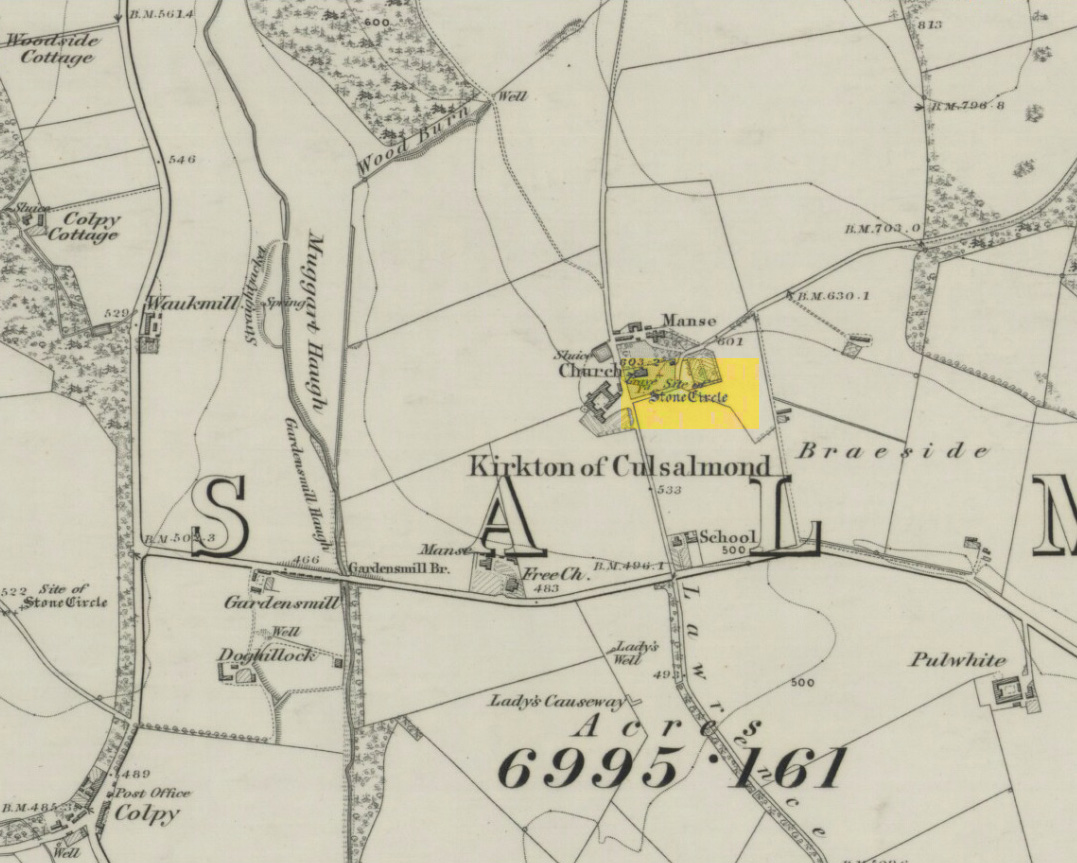Stone Circle (destroyed): OS Grid Reference – NJ 6503 3293
Also Known as:
Archaeology & History

After standing at the same spot for 3000 years or more, near the beginning of the 19th century this stone circle was destroyed by the self-righteous christian cult that was rampaging its way through cultures far and wide. After all, they needed to rid the area of local traditions and “improve” the locals, whether they liked it or not! Thankfully however, one of their creed—a reverend Ferdinand Ellis: minister of the parish for forty years—recorded its destruction in the New Statistical Account between 1834-45. Amongst a variety of important traditional monuments that once existed hereby,
“A Druidical place of worship anciently stood about the middle of the churchyard or burying ground. It consisted of a circle of twelve upright large granite stones from Benochee, which were overturned when the first Christian temple was erected. One of these was taken up in 1821 and now remains above ground, near the spot where it was taken up. The other eleven are still underground. This is proof that the first christian missionaries, in this country, erected their places of worship as near as possible to the holy hills of the heathens, that the people might be more easily persuaded to assemble there.”
‘Persuaded‘ being a very broad term indeed when it came to the land confiscation of indigenous folk…
The stone that Ellis said “was taken up in 1821 and now remains above ground” was gone when Fred Coles (1902) surveyed the site, but he told how an earlier antiquarian and writer for the Scottish Society of Antiquaries, J.G. Callander, lived nearby, and who was
“told by the aged sexton, Florance, that he many a time came across a great stone, when preparing graves, and that he had himself blasted these more than once.”
It seems that all trace of this single stone, and the rest of them, either still lay in the ground or were used for local building material.
When John Barnatt (1989) came to add this circle in his corpus, for some reason he postulated that
“the number of stones suggest it was a recumbent stone circle”,
…that is: a stone circle possessing one large stone in the ring that’s laid down with two standing stones either side. However, there seems no real evidence to show that this was the case.
References:
-
Barnatt, John, Stone Circles of Britain – volume 2, BAR: Oxford 1989.
-
Browne, G.F., On Some Antiquities in the Neighbourhood of Dunecht House, Aberdeenshire, Cambridge University Press 1921.
-
Burl, H.A.W., “The Recumbent Stone Circles of North-East Scotland“, in Proceedings Society of Antiquaries, Scotland, volume 102, 1973.
-
Burl, H.A.W., The Stone Circles of the British Isles, Yale University Press 1976.
-
Burl, H.A.W., The Stone Circles of Britain, Ireland and Brittany, Yale University Press 2000.
- Coles, Fred R., “Report on Stone Circles in Aberdeenshire (Inverurie, Eastern Parishes, and Insch Districts),” in Proceedings Society of Antiquaries, Scotland, volume 36, 1902.
© Paul Bennett, The Northern Antiquarian
Lovely to see an Aberdeenshire entry, so close to where I live. When descriptions such as the ‘site of stone circle’ are recorded on maps, are they referring to the point marked by the +, in this case in the grave yard?
Hi Anne 🙂 – Aye, the “+” marks the spot. And the OS-maps tend to be damn close when they mark it. It’s rare they get it wrong. Two other megalithic rings were close to this one – they too have apparently been destroyed. I’ll do their site profiles soon enough and have them on the map in the next week or 2. I’m wanting to get up into that area sometime next year. It looks to have been a megalithic paradise!
that’s great, let us know when you get up to this area, I have a small and growing group of folk interested in the heritage of this area and we are interested in finding out more about our stones and sites. In the meantime have a look for therhynieman and huntlyhistories on twitter and follow the links from there to projects I’m involved in, best wishes, Anne